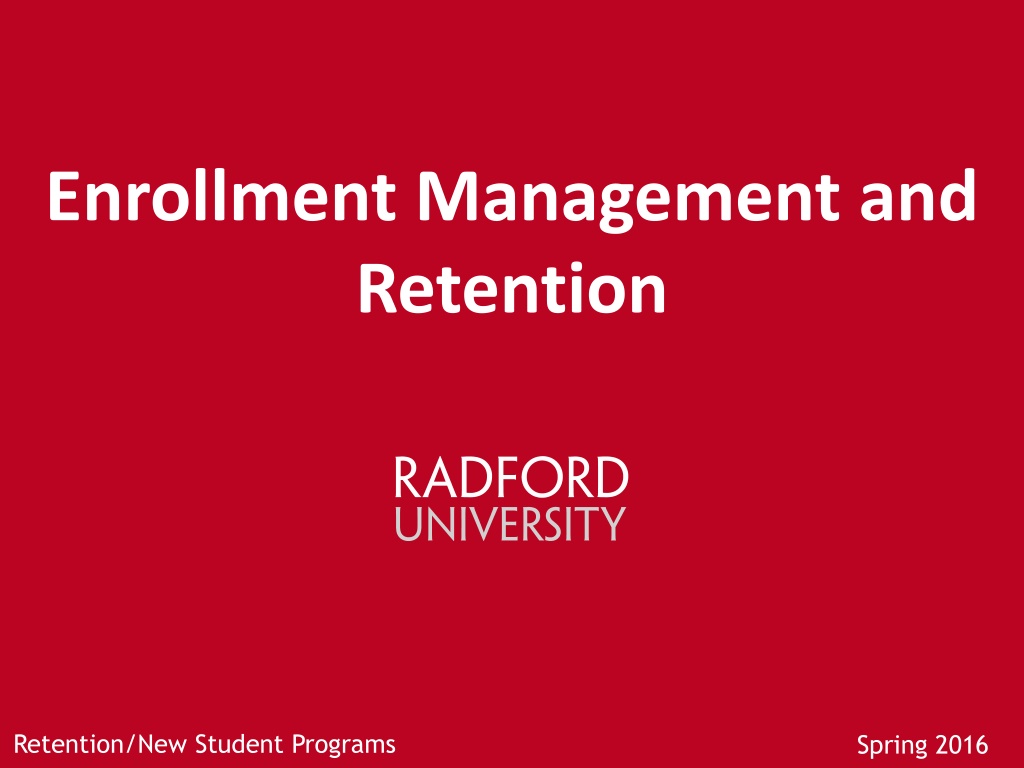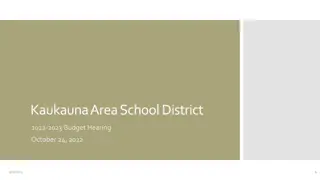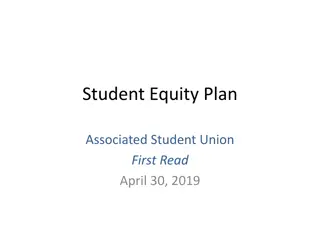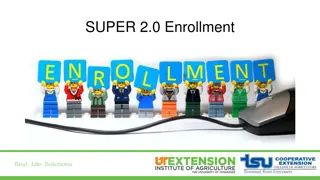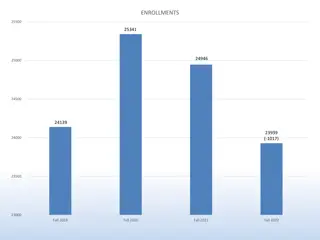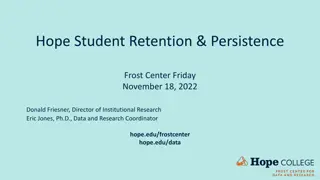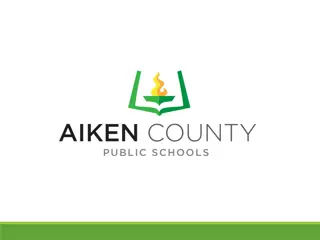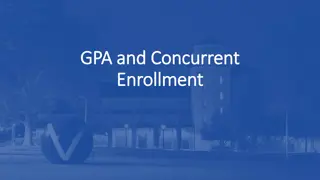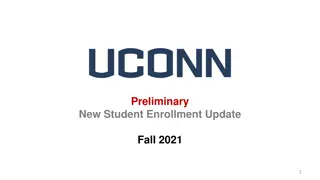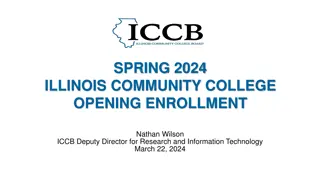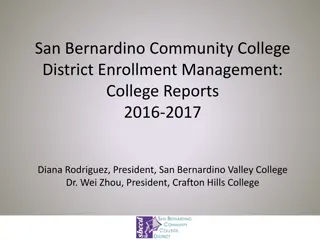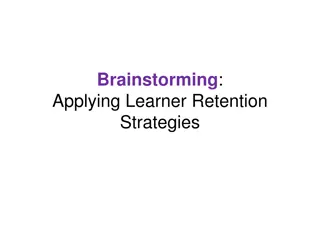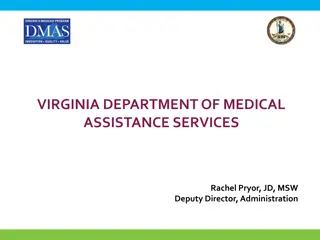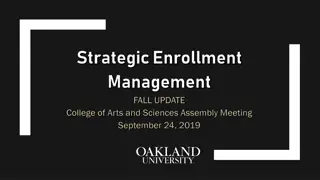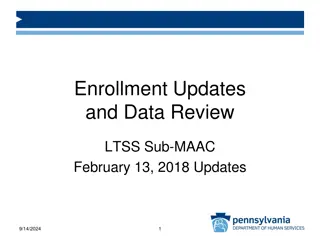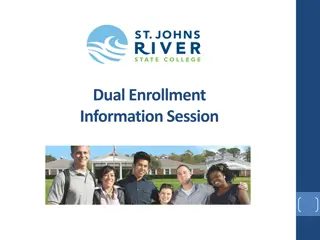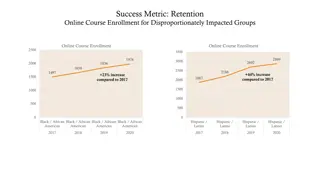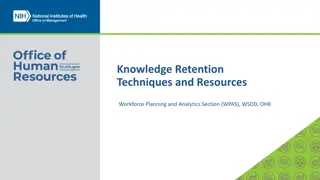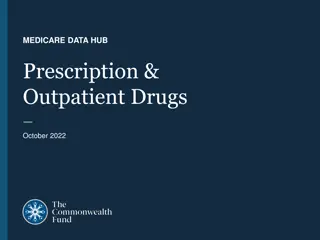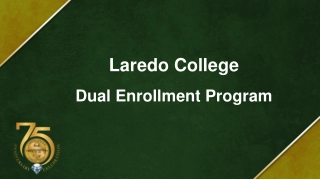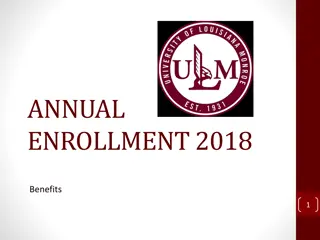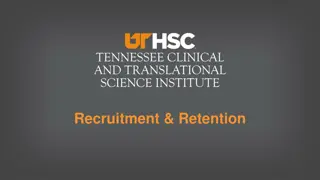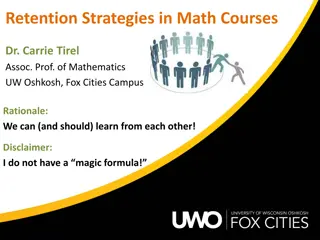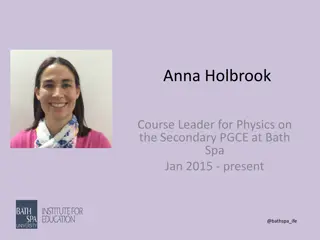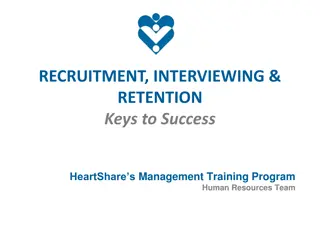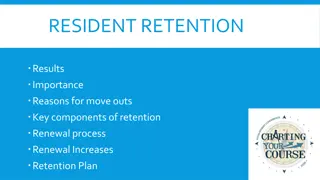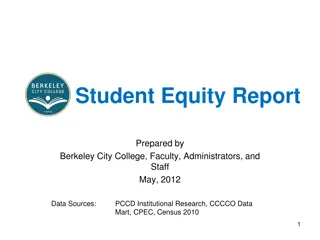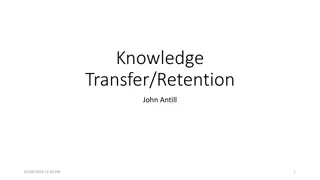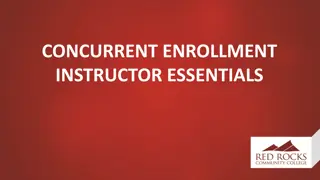Insight into Student Enrollment and Retention Strategies for 2016
Delve into the challenges and strategies surrounding student retention and enrollment management in the academic year 2015-2016. Discover data on retention rates, student profiles, and the effectiveness of new student programs at RU. Gain insights into the need for faculty involvement, changes in retention rates over the years, and the impact of academic standing on student attrition.
Download Presentation

Please find below an Image/Link to download the presentation.
The content on the website is provided AS IS for your information and personal use only. It may not be sold, licensed, or shared on other websites without obtaining consent from the author. Download presentation by click this link. If you encounter any issues during the download, it is possible that the publisher has removed the file from their server.
E N D
Presentation Transcript
Enrollment Management and Retention Retention/New Student Programs Spring 2016
New Student Programs Updates/Requests Quest 2016 New philosophy: Success messaging with focus on June-September 1 Need for deans participation UNIV 100 Fall 2016 Textbook D2L Recruitment of Faculty Instructors Retention/New Student Programs
Current Retention Issues 2015-2016 Fall-to-Spring Retention Rates were the Lowest in 20 Years: Fall-to-Spring Retention (New Freshmen) Cohort Retain SQ 1,986 1,748 118 2,015 1,778 121 1,962 1,689 123 Change 2014-2015 Term Fall 2013 Fall 2014 Fall 2015 PB 30 32 33 GS 90 84 117 Retain 88.0% 88.2% 86.1% -1.9% SQ 5.9% 6.0% 6.3% 0.3% PB 1.5% 1.6% 1.7% 0.2% The average fall-to-spring retention rate for the Fall 2003-Fall 2012 cohorts was 90.6%. Source for all data in presentation (unless otherwise indicated): RU Office of Institutional Research Retention/New Student Programs
RU is Losing Students at Both Ends of the Qualifications Spectrum: Approximately 8% of Fall 2015 new freshmen who were not retained were not in good standing after the fall semester: 6.3% of new freshmen were suspended 1.7% could have returned on academic probation, but did not Approximately 6% left in good academic standing, compared to 4.5% following fall 2013 and 4.1% following fall 2014. What is happening? Have been working with Institutional Research to gather information. Retention/New Student Programs
Who Are Our Students? 2015-2016 First-Time Freshman Profile (GPA) Median SAT Math 4.26 680 4.17 680 Institution UVA CWM Median HSGPA Median SAT Verbal 670 680 Median Total SAT 1350 1360 VT CNU JMU GMU VMI VCU UMW LU UVA-W ODU RU NSU VSU 3.98 3.80 3.79 3.65 3.63 3.60 3.54 3.42 3.42 3.27 3.14 2.93 2.93 630 570 560 570 570 550 530 490 470 510 480 370 420 590 580 560 570 560 540 550 490 470 510 480 370 430 1220 1150 1120 1140 1130 1090 1080 980 940 1020 960 740 850 Source: SCHEV. (RU s median HSGPA since 2010 has ranged between 3.11 and 3.19.) Retention/New Student Programs
Who Are Our Students? 2015-2016 First-Time Freshman Profile (SAT) Institution Median HSGPA Median SAT Math Median SAT Verbal Median Total SAT CWM 4.17 680 680 1360 UVA 4.26 680 670 1350 VT 3.98 630 590 1220 CNU 3.80 570 580 1150 GMU 3.65 570 570 1140 VMI 3.63 570 560 1130 JMU 3.79 560 560 1120 ODU 3.27 510 510 1120 VCU 3.60 550 540 1090 UMW 3.54 530 550 1080 LU 3.42 490 490 980 RU 3.14 480 480 960 UVA-W 3.42 470 470 940 VSU 2.93 420 430 850 NSU 2.93 370 370 840 Source: SCHEV. (RU s median SAT in 2010 was 1020.) Retention/New Student Programs
Conclusions . . . 1.Our state competitors are not who we think they are. 2.Many of our freshmen almost certainly need additional support to succeed. Retention/New Student Programs
Radford University Probation/Suspension Policy (In Effect Since Fall 2013) The academic suspension threshold for continuing students is determined by the number of hours attempted, according to the following scale: Hours Attempted Cumulative GPA Required to Avoid Suspension 13-23 1.00 24-35 1.50 36-47 1.80 48 or more 2.00 Students with cumulative GPAs below 2.00 but above the suspension thresholds are placed on academic probation. Retention/New Student Programs
Students Who Do Not Find Success Early are Less Likely to Graduate About 6% of new freshmen are suspended each fall and another 13% are on academic probation. Even those on probation are unlikely to graduate: All RU Students Graduated 6 Years 55% 60% 59% 59% 59% - - - - - Probation Retained Spring 93% 93% 93% 93% 93% 89% 93% 91% 90% 89% Probation Retained Fall 61% 69% 71% 62% 64% 64% 61% 68% 61% 62% Probation Graduated 6 Years 32% 35% 33% 22% 40% - - - - - Good Standing Probation Suspension 83% 13% 86% 8% 87% 8% 88% 8% 83% 9% 84% 10% 80% 12% 83% 11% 79% 15% 79% 15% Term Fall 2005 Fall 2006 Fall 2007 Fall 2008 Fall 2009 Fall 2010 Fall 2011 Fall 2012 Fall 2013 Fall 2014 Cohort 1,896 1,733 1,841 1,875 1,447 1,837 2,035 2,053 1,986 2,015 4% 6% 5% 4% 7% 6% 8% 7% 6% 6% For all RU new freshmen: 90% were retained spring; 76% were retained fall. Retention/New Student Programs
Question: Who is in Greatest Need of Support in Order to Be Retained? Answer: Students with Low High School Grade Point Averages High School GPA Total Number 1493 1479 16 1528 1528 6044 Number Persisted 1225 1168 12 1144 1029 4578 Persistence Rate (%) 82.05 78.97 75.00 74.87 67.34 75.74 Rank 1 2 3 4 5 Total Value Lift 1.08 1.04 0.99 0.99 0.89 1.00 3.46 or Greater 3.14 to 3.45 ZZ 2.84 to 3.13 2.83 or Less Source: Ruffalo Noel Levitz Spring 2015 Retention Model for Radford University Retention/New Student Programs
Ruffalo Noel Levitz RU 2015 Standard Retention Predictor (SRP) Model Source: Ruffalo Noel Levitz Spring 2015 Retention Model for Radford University Retention/New Student Programs
Predictive Value of the Model, 2012-2014 Source: Ruffalo Noel Levitz Spring 2015 Retention Model for Radford University Retention/New Student Programs
Question: Who is in Greatest Need of Support in Order to Be Retained? . . . NOT Students with Low SAT Scores: SAT Combined Score Total Number 1218 1224 1278 1188 1136 6044 Number Persisted 938 936 965 889 850 4578 Persistence Rate (%) 77.01 76.47 75.51 74.83 74.82 75.74 Rank 1 2 3 4 5 Total Value 921 to 990 1071 or Greater 920 or Less 991 to 1070 ZZ Lift 1.02 1.01 1.00 0.99 0.99 1.00 Source: Ruffalo Noel Levitz Spring 2015 Retention Model for Radford University Retention/New Student Programs
Fall 2015 Conditional Admits Approximately 30 students with acceptable high school GPAs but low SAT scores were conditionally admitted. Conditions: Enrollment in UNIV 100 Schedules created by professional advisors Regular meetings with advisors Participation in MASH (Mentoring Academically Successful Highlanders): peer mentoring, workshops, intrusive advising, etc. The program was very successful, but since HSGPA is the best predictor of retention, the conditional admits were less of a retention risk than about 500 other new freshmen . . . Retention/New Student Programs
Conditional Admits and Other NF by HSGPA New Freshmen Profile Percentages (Fall 2015) by HSGPA Percentile* HSGPA SAT Combined 5th 2.48 830 10th 2.59 850 15th 2.66 870 20th 2.74 880 25th 2.80 890 Conditional Admits 2.85 800 30th 2.87 910 35th 2.94 920 *Each percentile represents approximately 100 students. Retention/New Student Programs
Recommendation: If we offer students conditional admission and provide those students with additional support, the students offered conditional admission should be determined by their high school GPAs, not their SAT scores. Retention/New Student Programs
A Critical Retention Reality: We Must Teach the Students We Have, Not Those We Wish We Had If improving retention rates is a goal (and it should be, if only for the selfish reason than improved retention rates enables the Office of Admissions to be more selective!) we must provide additional support to Radford University freshmen. Some recommendations, first for students with lesser entrance criteria . . . Retention/New Student Programs
Recommendations: 1. Offer more sections of courses in which freshmen find success. This will enable advisors to . . . 2. Place more students in balanced first-semester schedules that are more conducive to their success. 3. Use CSI results (e.g., responses to questions about math/science and verbal/writing confidence) and SRP scores to inform first-semester schedule construction. A new student s academic success during the first semester should be dependent upon his/her effort and motivation, not whether he/she got first choices or leftovers because of how early or late in the process he registered. (Source: Retention at Radford University: Current Status and Recommendations for Enhancement, Lerch, Dunn, and Jenkins, December 2012). Retention/New Student Programs
The Combination of Classes New Freshmen Take Dramatically Affect their GPAs/Retention DFW Rates for New Freshman Courses (Fall 2015) Click here to open the Excel file Retention/New Student Programs
Recommendations (continued): 4. Require faculty to assign meaningful midterm grades. Midterm grades predict final grades and have critical advising implications. Final Grade C- D+ 0% 0% 1% 0% 1% 0% 0% 100% 3% 2% 1% 1% 2% 1% 0% 100% 2% 2% 2% 0% 2% 1% 0% 100% A A- B+ B B- C+ C D D- F W I Total DFW 67% 6% 5% 14% 1% 1% 35% 17% 14% 15% 4% 2% 23% 11% 15% 21% 7% 5% 23% 3% 4% 36% 4% 2% 16% 1% 1% 4% 0% 3% 1% 0% 100% 9% 7% 6% 22% 14% 8% 17% 4% 2% 5% 2% 5% 1% 0% 100% 12% 7% 5% 9% 16% 10% 12% 15% 5% 2% 4% 2% 10% 3% 0% 100% 19% 7% 1% 2% 24% 4% 4% 27% 2% 2% 13% 1% 9% 4% 0% 100% 26% 5% 4% 6% 10% 9% 7% 19% 8% 6% 8% 5% 7% 5% 1% 100% 25% 3% 4% 5% 5% 5% 10% 15% 9% 5% 10% 5% 9% 12% 0% 100% 37% 4% 0% 0% 13% 2% 2% 24% 3% 2% 20% 2% 17% 11% 0% 100% 49% 1% 0% 0% 5% 3% 5% 9% 7% 4% 15% 12% 19% 20% 0% 100% 66% 1% 0% 0% 3% 1% 2% 8% 1% 2% 9% 2% 33% 35% 1% 100% 79% 29% 7% 2% 14% 4% 3% 6% 2% 2% 8% 2% 15% 5% 0% 100% 31% (blank) 32% 3% 4% 15% 3% 1% 7% Total 31% 5% 5% 18% 4% 3% 12% 2% 1% 6% 1% 7% 6% 0% 100% 20% A A- B+ B B- C+ C C- D+ D D- F I 3% 4% 8% 3% 4% 5% 9% Mid-Term Grade 2% 1% 5% 1% 6% 20% 0% 100% 31% Retention/New Student Programs
Recommendations (continued): 5. Advise freshmen to strategically use course withdrawals. This should turn some suspensions into probation, giving the student a second chance (with the support of UNIV 150) in the spring. UNIV 150 has a two-year successful track record: Year One of UNIV 150 (Spring 2014) New Freshmen with Fall 2013 GPA 1.00-1.49 Retention Rates Spring 2014 UNIV 150 Spring 2014 Fall 2014 Spring 2015 Fall 2015 Spring 2016 Passed UNIV 150 (with C or above) 100.0% Did not pass UNIV 150 (D, F, W) 100.0% Did not enroll in UNIV 150 64.9% Total 88.8% 77.4% 11.8% 40.5% 56.0% 50.0% 5.9% 29.7% 37.1% 45.2% 5.9% 27.0% 33.6% 45.2% 5.9% 27.0% 33.6% New Freshmen with Fall 2013 GPA 1.50-1.99 Retention Rates Spring 2014 UNIV 150 Spring 2014 Fall 2014 Spring 2015 Fall 2015 Spring 2016 Passed UNIV 150 (with C or above) 100.0% Did not pass UNIV 150 (D, F, W) 100.0% Did not enroll in UNIV 150 86.5% Total 90.4% 75.6% 42.9% 60.3% 63.5% 66.7% 42.9% 46.0% 51.1% 55.6% 42.9% 40.5% 44.4% 51.1% 28.6% 39.7% 42.1% Retention/New Student Programs
Recommendations (continued): Year Two of UNIV 150 (Spring 2015) New Freshmen with Fall 2014 GPA 1.00-1.49 Retention Rates Spring 2014 UNIV 150 Spring 2014 Fall 2014 Spring 2015 Fall 2015 Spring 2016 Passed UNIV 150 (with C or above) x Did not pass UNIV 150 (D, F, W) x Did not enroll in UNIV 150 x Total x x x x x 100.0% 100.0% 54.1% 85.6% 79.0% 15.8% 35.1% 55.1% 58.1% 15.8% 29.7% 42.4% New Freshmen with Fall 2014 GPA 1.50-1.99 Retention Rates Spring 2014 UNIV 150 Spring 2014 Fall 2014 Spring 2015 Fall 2015 Spring 2016 Passed UNIV 150 (with C or above) x Did not pass UNIV 150 (D, F, W) x Did not enroll in UNIV 150 x Total x x x x x 100.0% 100.0% 89.4% 91.6% 90.6% 50.0% 62.4% 67.0% 78.1% 33.3% 51.8% 55.9% Retention/New Student Programs
Recommendations (continued): 6. Advise students to withdraw from Radford University if their midterms are universally bad. (This obviously is not a retention strategy, but it is the right thing to do.) Below 1.0 At Mid-Term Good Standing Probation Suspension 4 7 4 1 5 1 2 4 2 3 8 5 14 4 7 3 8 12 8 14 Withdrew None 10 10 8 7 8 10 13 14 32 22 Withdrew Some 8 6 7 7 10 15 26 19 23 31 Withdrew All 3 3 4 1 2 5 10 4 4 5 Graduated 6 Years 2 (9.5%) 1 (5.2%) 1 (5.2%) 2 (13.3%) 4 (20.0%) - - - - - Term Fall 2005 Fall 2006 Fall 2007 Fall 2008 Fall 2009 Fall 2010 Fall 2011 Fall 2012 Fall 2013 Fall 2014 Count 21 19 19 15 20 30 49 37 59 58 10 14 13 9 15 17 31 27 39 36 Retention/New Student Programs
Recommendations (continued): 7. Require UNIV 100 for all freshmen, or at least for those in the bottom 25% of high school GPAs and for late admits. 8. Discontinue restrictive major change policies. 9. Involve families by reactivating the electronic family newsletter and changing the FERPA waiver to make it proactive. 10.Implement a University-wide attendance policy for 100-level courses. 11.Connect freshmen earlier to information about potential careers. 12.Implement a long-range plan to staff advising centers such that all freshmen are advised by professional advisors. Retention/New Student Programs
Recommendations (continued): 13.Implement Starfish to its fullest capacities as soon as feasible. 14.Arrange for full-time, tenure-track faculty not adjuncts or teaching assistants to teach more freshman-level courses, especially introductory courses for their majors. 15.Through faculty development, help faculty assigned to teach 100-level classes understand the special challenges and rewards of teaching college freshmen. Retention/New Student Programs
We Must Also Recruit and Retain Outstanding Students! Recruitment Questions: Is there sufficient financial incentive for students to choose RU? Our lower tuition is not sufficiently offset by availability of merit scholarships . . . Good students will not choose us if they receive more money to go elsewhere! Can we expand the Honors Academy? Have we made the new criteria too restrictive? Are we doing everything we can to support the Office of Admissions? James and his staff need our full commitment and support, as well as our facilities and our participation in recruitment activities. Retention/New Student Programs
We Must Also Recruit and Retain Outstanding Students! Retention: We lose too many good students: Dean's List Retention Rate Dean's List N Spring Fall 2008 1,875 470 95% Fall 2009 1,447 368 97% Fall 2010 1,837 505 96% Fall 2011 2,035 474 95% Fall 2012 2,053 492 97% Fall 2013 1,986 495 95% Fall 2014 2,015 483 97% Good Standing (but not DL) N Spring 1,181 95% 837 95% 1,042 93% 1,159 93% 1,206 93% 1,074 94% 1,110 94% Difference Spring 0% 2% 3% 2% 4% 1% 3% Term Cohort Fall 81% 81% 84% 81% 85% 82% 88% Fall 82% 83% 81% 82% 83% 82% 81% Fall -1% -2% 3% -1% 2% 0% 7% We must connect good students as early as possible with their major curricula, faculty, departments, schools, and colleges. We must connect good students to High Impact Practices designed to engage and challenge them. We must offer incentives for outstanding students to stay. Retention/New Student Programs
Questions? Retention/New Student Programs
